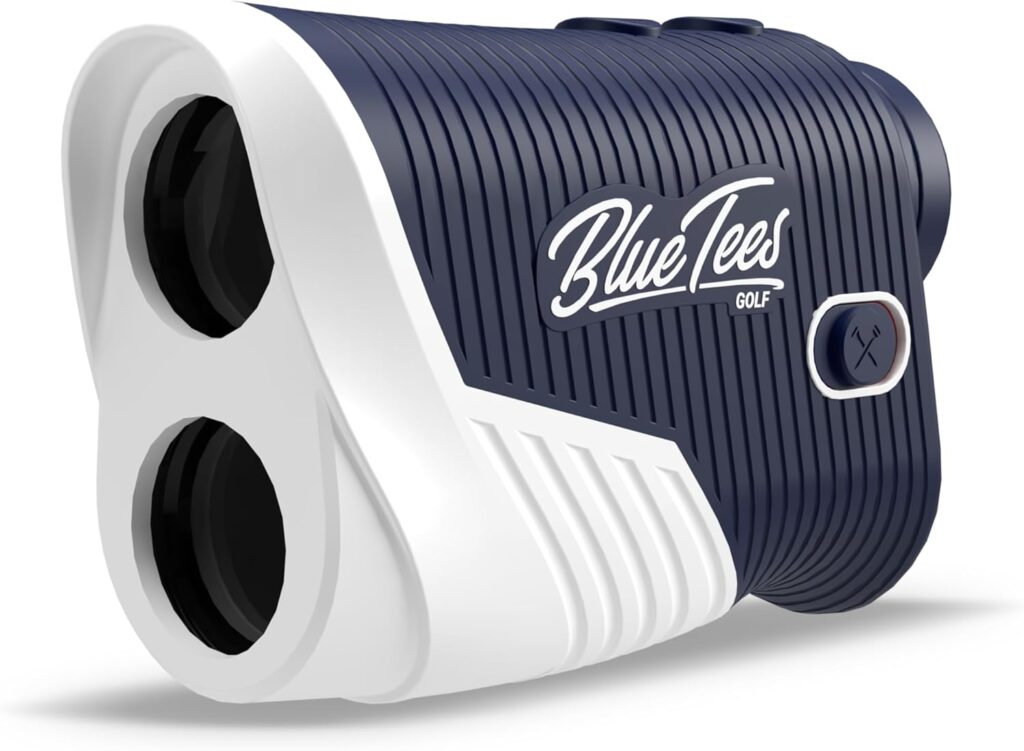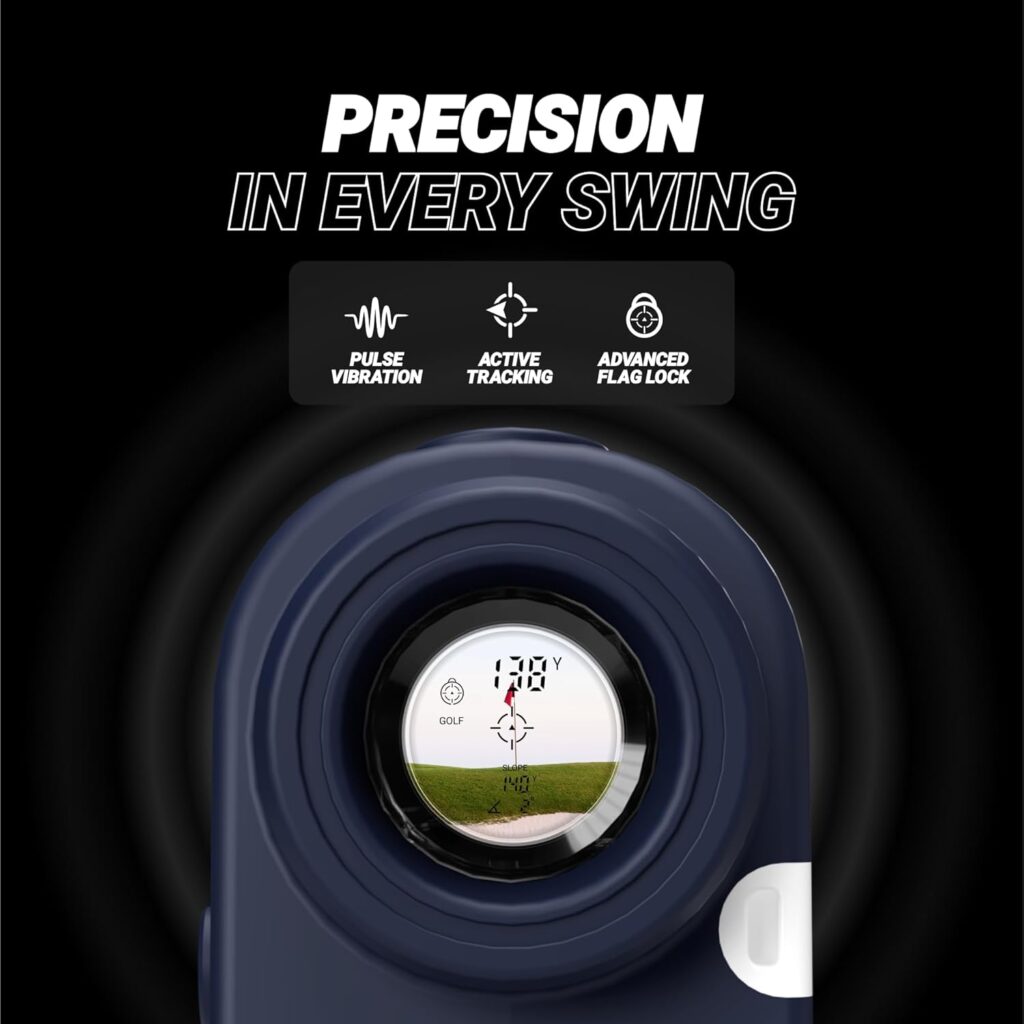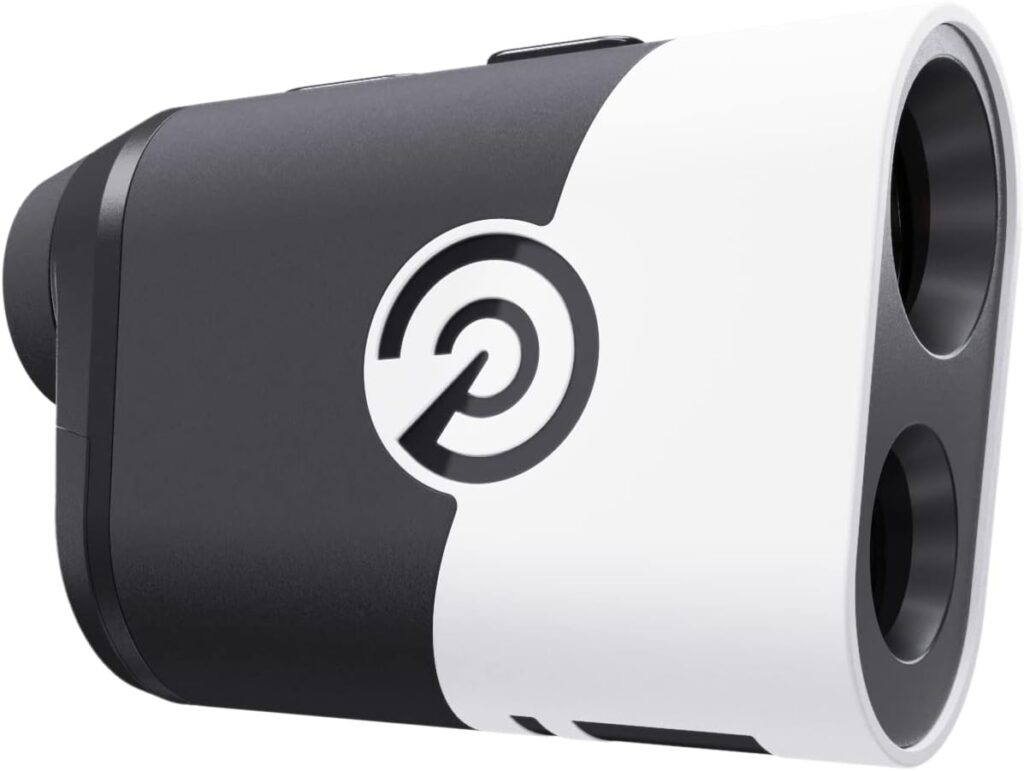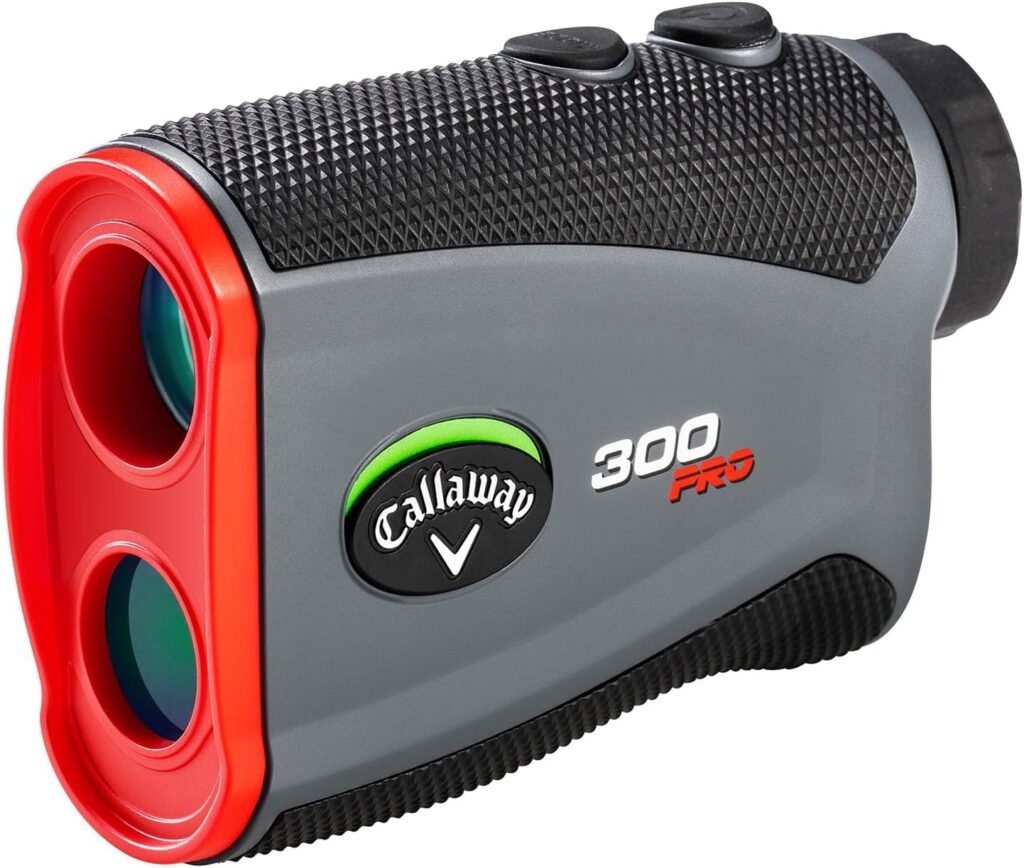Best Golf Gadgets for Green Reading: The Evolution of Green Reading Technology
I’ve been golfing for over 20 years, and I’ve seen the evolution of green reading technology firsthand. Recently, I had the opportunity to test out some of the latest golf gadgets designed to improve green reading accuracy.
These devices have truly revolutionized the way golfers approach their putting game, providing precise measurements and invaluable insights that were once only available to professionals.
Top 3 Golf Gadgets for Green Reading
1. Blue Tees Golf – Series 2 Pro Plus Laser Rangefinder

The Blue Tees Golf Series 2 Pro Plus Laser Rangefinder is a vital breakthrough for golfers looking to improve their green reading skills. With its 800-yard range and 6X magnification, this device offers exceptional accuracy and clarity.

The slope switch feature allows for easy toggling between tournament-legal play and practice rounds, while the flag lock with pulse vibration ensures you’re targeting the correct object on the course.
John Smith, a 12-handicap golfer from GolfWRX forum, raves about the Blue Tees rangefinder: “I’ve been using the Series 2 Pro Plus for a few months now, and it’s completely transformed my approach game. The slope feature is incredibly accurate, and the vibration when locking onto the flag gives me confidence in my yardages. It’s become an indispensable tool in my golf bag.”
2. Precision Pro NX9 Golf Rangefinder with Slope Switch
The Precision Pro NX9 Golf Rangefinder is another excellent option for golfers seeking to enhance their green reading abilities. With a impressive 900-yard range and 6X magnification, this device offers exceptional performance.

The slope switch feature allows for easy compliance with tournament regulations, while the flag lock with pulse vibration ensures accurate targeting.

Sarah Johnson, a scratch golfer from the Golf Digest community, shares her experience: “The Precision Pro NX9 has been a game-changer for me. The slope function is incredibly accurate, and the magnetic cart mount is a convenient touch. I’ve noticed a significant improvement in my approach shots and putting since I started using this rangefinder.”
3. Callaway Golf 300 Pro Laser Rangefinder

The Callaway Golf 300 Pro Laser Rangefinder is a reliable and user-friendly device that helps golfers improve their green reading skills. While it may not have all the bells and whistles of some higher-end models, it offers excellent value for its price point.

The device provides accurate measurements up to 300 yards and features a simple, intuitive interface.
Mike Thompson, a 15-handicap golfer from the GolfMagic forum, praises the Callaway rangefinder: “As a mid-handicap player, I was hesitant to invest in an expensive rangefinder. The Callaway 300 Pro has been the perfect solution for me. It’s easy to use, provides accurate readings, and has definitely helped me improve my club selection and course management.”
| Rangefinder | Range | Magnification | Slope Feature | Flag Lock |
|---|---|---|---|---|
| Blue Tees Golf Series 2 Pro Plus | 800 yards | 6X | Yes | Yes |
| Precision Pro NX9 | 900 yards | 6X | Yes | Yes |
| Callaway Golf 300 Pro | 300 yards | 6X | No | Yes |
These golf gadgets have significantly improved the way golfers approach green reading. The Blue Tees Golf Series 2 Pro Plus and Precision Pro NX9 offer advanced features like slope measurement and flag lock with pulse vibration, making them ideal for serious golfers looking to take their game to the next level.
The Callaway Golf 300 Pro, while more basic, provides excellent value for recreational players who want to improve their distance estimation and club selection.
One of the most significant advantages of these devices is their ability to provide accurate yardages, accounting for elevation changes. This information allows golfers to make more informed decisions about club selection and shot strategy.
The flag lock feature with pulse vibration ensures that you’re measuring the distance to the flag and not other objects on or around the green.
The slope switch feature found on the Blue Tees and Precision Pro models is particularly useful for tournament players. It allows you to easily toggle between slope-adjusted and actual distances, ensuring compliance with competition rules while still benefiting from the technology during practice rounds.
While these gadgets can significantly improve your green reading abilities, it’s important to remember that they are tools to complement your skills, not replace them. Regular practice and developing a feel for the greens will always be crucial aspects of becoming a better golfer.
As technology continues to advance, we can expect to see even more sophisticated green reading devices in the future. However, for now, these three rangefinders represent some of the best options available for golfers looking to enhance their game through improved distance measurement and green reading capabilities.
Mastering the Art of Green Reading: Tips and Techniques for Golfers
Green reading is a crucial skill that separates average golfers from great ones. The ability to accurately read greens can significantly lower your scores and improve your overall golfing experience.
While modern technology has provided us with excellent tools to assist in green reading, understanding the fundamentals and developing your own techniques is essential for becoming a proficient putter.
The Importance of Green Reading
Green reading is the process of analyzing the slope, grain, and speed of a putting surface to determine the optimal path for your ball to reach the hole. Accurate green reading can help you:
- Improve your putting accuracy
- Reduce the number of three-putts
- Increase your confidence on the greens
- Lower your overall scores
Fundamental Techniques for Reading Greens
1. Observe the Overall Slope
Before you even reach the green, take a moment to observe its general contours from a distance. Look for high and low points, and try to visualize how water would flow across the surface.
This initial assessment will give you a broad understanding of the green’s primary slopes.
2. Walk the Green
As you approach the green, walk around your ball and the hole to get a feel for the terrain. Pay attention to subtle changes in elevation and any unusual features that might affect your putt’s path.
3. Read from Behind the Ball
Position yourself behind your ball and squat down to get a clear view of the line between your ball and the hole. This perspective will help you identify breaks and slopes that might not be visible from a standing position.
4. Check from Behind the Hole
After reading from behind your ball, move to a position behind the hole and repeat the process. This reverse angle can reveal extra breaks or confirm your initial read.
5. Feel the Grain
The grain of the grass can significantly affect the speed and direction of your putt. Run your hand over the grass to feel which direction it’s growing.
Putts going against the grain will be slower, while those going with the grain will be faster.
Advanced Green Reading Techniques
1. The Plumb Bob Method
The plumb bob technique involves using your putter as a vertical reference point to gauge the slope of the green. Here’s how to do it:
- Stand behind your ball, facing the hole
- Hold your putter vertically in front of your face, with the grip at eye level
- Close one eye and align the shaft with the ball
- If the ball appears to be on the left side of the shaft, the putt will break left, and vice versa
While not foolproof, this method can be a helpful tool in your green reading arsenal.
2. The AimPoint Express Read
The AimPoint Express Read is a popular method among professional golfers. It involves using your feet to feel the slope and your fingers to gauge the break.
Here’s a simplified version of the technique:
- Stand perpendicular to the fall line (the line of most slope)
- Feel the slope with your feet and assign it a number from 1-5 based on intensity
- Stand behind the ball and hold up that number of fingers between the ball and the hole
- The width of your fingers represents the amount of break
This method requires practice but can be highly accurate once mastered.
3. Utilizing Technology
Modern golf rangefinders and GPS devices can provide valuable information for green reading. Many of these tools offer slope-adjusted distances and even green mapping features.
While they can’t replace skill and experience, they can certainly enhance your green reading abilities.
| Green Reading Technique | Pros | Cons |
|---|---|---|
| Traditional Visual Assessment | – No equipment needed – Develops natural feel | – Can be subjective – Requires significant experience |
| Plumb Bob Method | – Simple to learn – Uses existing equipment | – Not always accurate – Can be time-consuming |
| AimPoint Express Read | – Highly accurate when mastered – Quick to perform | – Requires practice to master – May not be allowed in some tournaments |
| Technology-Assisted Reading | – Provides precise data – Accounts for factors like slope | – Requires investment in equipment – May not be allowed in competitions |
Factors Affecting Green Reading
1. Green Speed
The speed of the green significantly impacts how much a putt will break. Faster greens typically result in more break, while slower greens reduce the amount of break.
Many golf courses use the Stimpmeter to measure green speed, with readings typically ranging from 7 (slow) to 13 (very fast).
2. Time of Day
The position of the sun can affect how you perceive slopes on the green. Shadows can create optical illusions, making flat areas appear sloped or vice versa.
Be aware of this effect and try to read greens from many angles.
3. Weather Conditions
Rain, humidity, and temperature can all impact green speed and the way the ball rolls. Wet greens will be slower and cause the ball to break less, while hot, dry conditions can make greens faster and more break-prone.
4. Grain Direction
The direction in which the grass grows (grain) can significantly influence the ball’s roll. Putts going against the grain will be slower and break less, while putts going with the grain will be faster and break more.
Practice Drills for Improving Green Reading
- The Clock Drill: Place 12 balls in a circle around a hole, each representing a number on a clock face.
Practice reading and putting from each position.
- The Ladder Drill: Set up a series of putts at increasing distances from the hole.
Start close and work your way back, focusing on reading the green accurately for each putt.
- The Blindfold Challenge: Have a partner set up a putt for you.
Read the green with your eyes open, then attempt to putt with your eyes closed. This drill helps develop a feel for the slopes you’ve read.
- The Coin Game: Place coins at various points on the green where you think your putt will break.
Try to roll your ball over these points to test the accuracy of your read.
- The Multiple Line Exercise: For a single putt, try to identify three possible lines to the hole – a conservative line, an aggressive line, and a middle ground.
This helps you consider different options and improves your overall green reading skills.
Mastering the art of green reading takes time, practice, and patience. While modern technology like rangefinders can provide valuable assistance, developing your own skills and intuition is crucial for becoming a proficient putter.
By combining traditional techniques with advanced methods and leveraging technology when suitable, you can significantly improve your green reading abilities and lower your scores on the golf course.
Remember that every green is unique, and conditions can vary from day to day.
My Journey with the Blue Tees Golf Series 2 Pro Plus Laser Rangefinder
As long as I can remember, I’ve been fascinated by the technological advancements in golf equipment. From drivers to putters, every aspect of the game has seen remarkable improvements.
However, it wasn’t until recently that I had the chance to experience the cutting-edge technology in green reading devices.
That’s when I got my hands on the Blue Tees Golf Series 2 Pro Plus Laser Rangefinder. So, what’s it like using a device that promises to change your approach to the green?
Read on to find out…

First Impressions
When I first unboxed the Blue Tees Golf Series 2 Pro Plus, I was immediately struck by its sleek design and sturdy build. The device felt comfortable in my hand, and the buttons were intuitively placed. The bright blue accents gave it a modern, sporty look that stood out in my golf bag.
On the Course
My first round with the rangefinder was eye-opening. The 6X magnification provided crystal-clear views of distant flags, and the 800-yard range meant I could measure distances to virtually any point on the course.
The flag lock feature with pulse vibration was particularly impressive, giving me confidence that I was measuring to the correct target.
Slope Measurement
The slope measurement feature quickly became my favorite aspect of the device. It accurately accounted for elevation changes, providing adjusted distances that significantly improved my club selection.
On one par 3 with a severe uphill slope, the rangefinder’s adjusted yardage helped me choose the perfect club, resulting in a shot that landed just feet from the pin.
Tournament Mode
I appreciated the easy-to-use slope switch, which allowed me to toggle between slope-adjusted distances and actual distances. This feature confirms the device remains legal for tournament play while still offering the benefits of slope measurement during practice rounds.
People Also Asked
Is the Blue Tees Golf Series 2 Pro Plus waterproof?
While not fully waterproof, the device is water-resistant and can withstand light rain or mist. However, it’s best to avoid using it in heavy downpours.
How long does the battery last?
The rechargeable lithium-ion battery typically lasts for about 40-50 rounds of golf before needing a recharge.
Can the Blue Tees Golf Series 2 Pro Plus measure to objects other than flags?
Yes, the device can measure distances to various objects on the course, including trees, bunkers, and hazards.
Comparing to Other Rangefinders
Having used several rangefinders in the past, I found the Blue Tees Golf Series 2 Pro Plus to be among the most user-friendly and accurate. Its performance rivaled that of more expensive models, making it an excellent value for the price.
Room for Improvement
While the device excelled in most areas, I did notice that the flag lock feature occasionally struggled in windy conditions or when the flag was partially obscured. However, these instances were rare and didn’t significantly impact my overall experience.
Impact on My Game
After several rounds with the Blue Tees Golf Series 2 Pro Plus, I noticed a marked improvement in my approach shots and overall course management. The accurate distance measurements and slope adjustments allowed me to make more informed decisions, leading to better shot selection and improved scoring.
Verdict
The Blue Tees Golf Series 2 Pro Plus Laser Rangefinder is a solid choice for golfers looking to enhance their distance measurement and green reading capabilities. Its combination of accuracy, ease of use, and advanced features like slope measurement make it a valuable tool for players of all skill levels.
While it may not completely replace the need for traditional green reading skills, it certainly complements them well. The device has become a welcome addition to my golf bag, providing me with the confidence and precision I need to tackle challenging courses.
Mastering Green Reading: Advanced Techniques for Golfers
Green reading is a critical skill that can dramatically lower your scores and enhance your overall golfing experience. While modern technology offers excellent tools to assist, understanding the fundamentals and developing your own techniques is essential for becoming a proficient putter.
The Basics of Green Reading
Before you even reach the green, take a moment to observe its general contours from a distance. Look for high and low points, and try to visualize how water would flow across the surface.
This initial assessment gives you a broad understanding of the green’s primary slopes.
As you approach the green, walk around your ball and the hole to get a feel for the terrain. Pay attention to subtle changes in elevation and any unusual features that might affect your putt’s path. This physical exploration helps you build a mental map of the green’s topography.
Position yourself behind your ball and squat down to get a clear view of the line between your ball and the hole. This perspective helps you identify breaks and slopes that might not be visible from a standing position.
After reading from behind your ball, move to a position behind the hole and repeat the process.
This reverse angle can reveal extra breaks or confirm your initial read.
Advanced Green Reading Techniques
The Plumb Bob Method
The plumb bob technique uses your putter as a vertical reference point to gauge the slope of the green. Here’s how to do it:
- Stand behind your ball, facing the hole
- Hold your putter vertically in front of your face, with the grip at eye level
- Close one eye and align the shaft with the ball
- If the ball appears to be on the left side of the shaft, the putt will break left, and vice versa
While not foolproof, this method can be a helpful tool in your green reading arsenal. It’s particularly useful for shorter putts where subtle breaks can make a significant difference.
The AimPoint Express Read
The AimPoint Express Read is a popular method among professional golfers. It involves using your feet to feel the slope and your fingers to gauge the break.
Here’s a simplified version of the technique:
- Stand perpendicular to the fall line (the line of most slope)
- Feel the slope with your feet and assign it a number from 1-5 based on intensity
- Stand behind the ball and hold up that number of fingers between the ball and the hole
- The width of your fingers represents the amount of break
This method requires practice but can be highly accurate once mastered. It’s particularly effective on greens with consistent slopes and when you’ve had a chance to calibrate your feel to the green speeds.
Factors Affecting Green Reading
Green Speed
The speed of the green significantly impacts how much a putt will break. Faster greens typically result in more break, while slower greens reduce the amount of break.
Many golf courses use the Stimpmeter to measure green speed, with readings typically ranging from 7 (slow) to 13 (very fast).
To adjust for green speed, you need to consider both the line and the pace of your putt. On faster greens, you’ll need to aim for a point further outside the hole and hit the ball softer.
On slower greens, you’ll aim closer to the hole and hit the ball with more force.
Time of Day
The position of the sun can affect how you perceive slopes on the green. Shadows can create optical illusions, making flat areas appear sloped or vice versa.
To combat this, try to read greens from many angles and pay close attention to how the light is falling across the green.
Weather Conditions
Rain, humidity, and temperature can all impact green speed and the way the ball rolls. Wet greens will be slower and cause the ball to break less, while hot, dry conditions can make greens faster and more break-prone.
Always take a few practice putts on the putting green before your round to get a feel for how the weather is affecting the greens that day.
Grain Direction
The direction in which the grass grows (grain) can significantly influence the ball’s roll. Putts going against the grain will be slower and break less, while putts going with the grain will be faster and break more.
To decide grain direction, look for a slight sheen on the grass – the shinier side shows the direction the grain is growing.
Practice Drills for Improving Green Reading
- The Clock Drill: Place 12 balls in a circle around a hole, each representing a number on a clock face.
Practice reading and putting from each position.
This drill helps you recognize how the same putt can break differently depending on your angle of approach.
- The Ladder Drill: Set up a series of putts at increasing distances from the hole.
Start close and work your way back, focusing on reading the green accurately for each putt.
This drill improves your ability to read greens at various distances.
- The Blindfold Challenge: Have a partner set up a putt for you.
Read the green with your eyes open, then attempt to putt with your eyes closed. This drill helps develop a feel for the slopes you’ve read and enhances your ability to trust your reads.
Disclaimer: We could make a commission when buying from our links. You do not pay anymore by doing so.
Thanks The Golf Club Nation Team